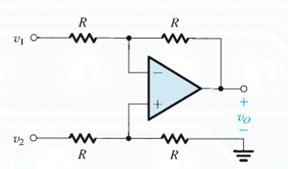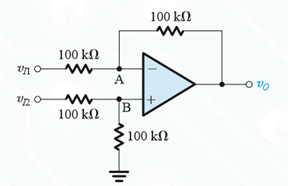This set of Electronic Devices and Circuits Multiple Choice Questions & Answers (MCQs) focuses on “Difference Amplifiers”.
1. For the difference amplifier which of the following is true?
a) It responds to the difference between the two signals and rejects the signal that are common to both the signal
b) It responds to the signal that are common to the two inputs only
c) It has a low value of input resistance
d) The efficacy of the amplifier is measured by the degree of its differential signal to the preference of the common mode signal
View Answer
Explanation: All the statements are not true except for the fact that it responds only when there is difference between two signals only.
2. If for an amplifier the common mode input signal is vc, the differential signal id vd and Ac and Ad represent common mode gain and differential gain respectively, then the output voltage v0 is given by
a) v0 = Ad vd – Ac vc
b) v0 = – Ad vd + Ac vc
c) v0 = Ad vd + Ac vc
d) v0 = – Ad vd – Ac vc
View Answer
Explanation: It is a standard mathematical expression.
3. If for an amplifier v1 and v2 are the input signals, vc and vd represent the common mode and differential signals respectively, then the expression for CMRR (Common Mode Rejection Ratio) is
a) 20 log (|Ad| / |Ac|)
b) -10 log (|Ac| / |Ad|)2
c) 20 log (v2 – v1 / 0.5(v2 + v1))
d) All of the mentioned
View Answer
Explanation: Note that all the expressions are identical.
4. The problem with the single operational difference amplifier is its
a) High input resistance
b) Low input resistance
c) Low output resistance
d) None of the mentioned
View Answer
Explanation: Due to low input resistance a large part of the signal is lost to the source’s internal resistance.
5. For the difference amplifier as shown in the figure show that if each resistor has a tolerance of ±100 ε % (i.e., for, say, a 5% resistor, ε = 0.05) then the worst-case CMRR is given approximately by (given K = R2/R1 = R4/R3)
![The worst-case CMRR is given by 20 log [K+1/4ε] for the difference amplifier](https://www.sanfoundry.com/wp-content/uploads/2017/06/electronic-devices-circuits-questions-answers-difference-amplifiers-q5.png)
a) 20 log [K+1/4ε].
b) 20 log [K+1/2ε].
c) 20 log [K+1/ε].
d) 20 log [2K+2/ε].
View Answer
Explanation: None.
6. For the circuit given below determine the input common mode resistance.
![The worst-case CMRR is given by 20 log [K+1/4ε] for the difference amplifier](https://www.sanfoundry.com/wp-content/uploads/2017/06/electronic-devices-circuits-questions-answers-difference-amplifiers-q5.png)
a) (R1 + R3) || (R2) || + (R4)
b) (R1 + R4) || (R2 + R3)
c) (R1 + R2) || (R3 + R4)
d) (R1 + R3) || (R2 + R4)
View Answer
Explanation: Parallel combination of series combination of R1 & R3 with the series combination of R3 and R4 is the required answer as is visible by the circuit.
7. For the circuit shown below express v0 as a function of v1 and v2.

a) v0 = v1 + v2
b) v0 = v2 – v1
c) v0 = v1 – v2
d) v0 = -v1 – v2
View Answer
Explanation: Considering the fact that the potential at the input terminals are identical and proceeding we obtain the given result.
8. For the difference amplifier shown below, let all the resistors be 10kΩ ± x%. The expression for the worst-case common-mode gain is

a) x / 50
b) x / 100
c) 2x / (100 – x)
d) 2x / (100 + x)
View Answer
Explanation: None.
9. Determine Ad and Ac for the given circuit.

a) Ac = 0 and Ad = 1
b) Ac ≠ 0 and Ad = 1
c) Ac = 0 and Ad ≠ 1
d) Ac ≠ 0 and Ad ≠ 1
View Answer
Explanation: Consider the fact that the potential at the input terminals are identical and obtain the values of V1 and V2. Thus obtain the value of Vd and Vc.
10. Determine the voltage gain for the given circuit known that R1 = R3 = 10kΩ abd R2 = R4 = 100kΩ.
![The worst-case CMRR is given by 20 log [K+1/4ε] for the difference amplifier](https://www.sanfoundry.com/wp-content/uploads/2017/06/electronic-devices-circuits-questions-answers-difference-amplifiers-q5.png)
a) 1
b) 10
c) 100
d) 1000
View Answer
Explanation: Voltage gain is 100/10.
Sanfoundry Global Education & Learning Series – Electronic Devices and Circuits.
To practice all areas of Electronic Devices and Circuits, here is complete set of 1000+ Multiple Choice Questions and Answers.
If you find a mistake in question / option / answer, kindly take a screenshot and email to [email protected]
